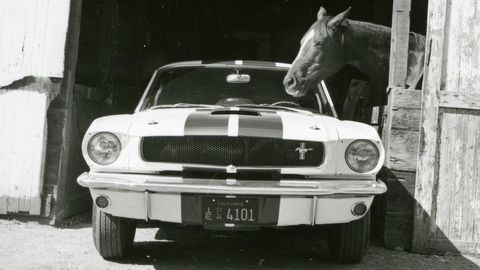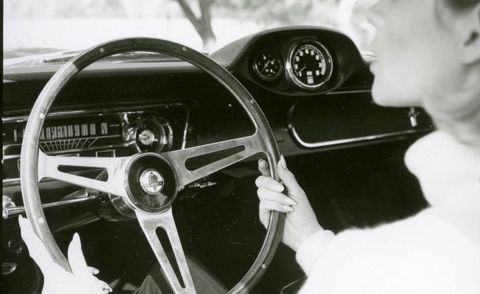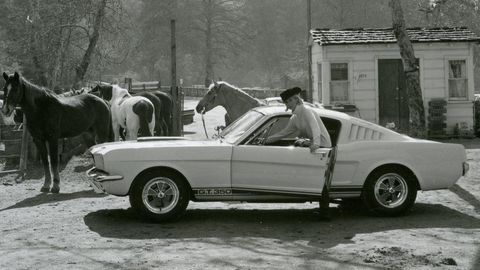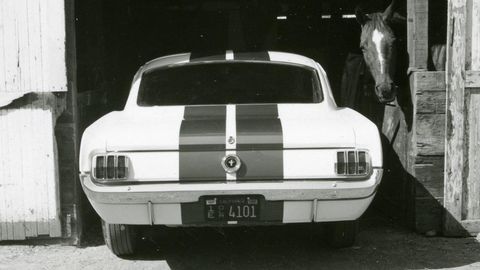From the May 1965 Issue of Car and Driver
Not content with his
Cobra-Powered-by-Ford, Carroll Shelby has now come up with a Ford-Powered-by-Cobra. The Ford in question is the “fastback” Mustang, and Shelby’s merry men have stuffed a burr of some size and effectiveness under its metaphorical saddle. The result is that while the Mustang is still recognizably the same horse, it has undergone a complete change of character. This new car, called the Mustang GT350, and known familiarly as the Shelby Mustang, will not have the mass appeal of the original, but by all that is sacred to us enthusiast-types, it certainly is a lot more interesting.
Basically, what Shelby has done is to convert the Mustang fastback coupe into a road-going version of a NASCAR stocker. There is a one-inch anti-roll bar across the front suspension that has all of the flexibility of a section of railroad iron, and oversized Koni adjustable shock absorbers set up hyper-hard. In addition, the front suspension has been noticeably de-cambered. The steering is speeded up 14% with altered steering geometry. At the rear, big, fat Konis are again used and a pair of trailing torque-control arms added. Completing the transformation in handling are 15-inch Kelsey-Hayes “mag-type” wheels with six-inch rims mounting wide, low-profile Goodyear tires. We should mention that these tires are special, semi-racing Goodyears, with low-angle nylon cord; safe at sustained speeds up to 130 mph
The Mustang GT350 also gives you a special brake package, consisting of the Kelsey-Hayes 11-inch discs up front and big drum brakes at the rear borrowed from the Ford station wagon line—3/4-inch wider than the stock Mustang rear brakes. The rear brakes are fitted with sintered-metal linings which, when combined with the racing pads used in the disc-brake calipers, provide a lot of stopping power. The one criticism we have regarding the brakes is that their pedal-pressure requirement is very high.
In the engine compartment, you’ll find a fairly standard Ford 289-cubic inch V-8, but with some Kobra Kustom accessories bolted on. Shelby starts with the 271-hp “High-Performance” version of the 289 V-8, and adds a high-riser intake manifold, welded-tube headers and cast-aluminum valve-rocker covers which raise peak power to 306. Also, the pressed-steel stock oil sump is replaced with a bathtub-sized cast-aluminum sump, complete with cooling fins and all that sexy stuff.
The 4-barrel carburetor fitted on the Cobra high-riser manifold has special jetting for the application (to make it compatible with the free-flow exhaust system) and “center-pivot” floats—which hold the fuel level fairly well even when it is sloshing about under the high side loads of cornering. The standard transmission for the GT350 is a four-speed, all-synchro unit with close ratios housed in an aluminum case and tailshaft. A ratchet-type limited slip differential is also standard equipment.
Those curious enough to peer under the GT 350’s hood will notice, in addition to the Cobra goodies on the engine, a tubular brace bolted across the engine bay—over the engine and just ahead of the air-cleaner. It is there, we were told, to stiffen the structure, which apparently has a tendency to flex inward at the fender tops under loads coming up from the suspension.
The hood is, by the way, one of the features that distinguishes the GT 350 from less exciting Mustangs. It is made of fiberglass (making it a couple of pounds lighter than its steel counterpart) and has a big air-scoop right in the middle. It is bolted to the same hinge-pieces as the stock hood, so the counter-balancing springs hold it open and you won’t need a hood prop, but the standard latch has been removed. The hood is held closed by the typical NASCAR arrangement of pins through dowels extending up through holes in the hood. These pins are secured by over-centering safety rings, and we would guess that the less responsible element among the younger set will make off with these pins as soon as the owner isn’t looking —if for no other reason than because the car has no hub-caps.
Apart from the hood, the onlooker will know the GT 350 when he sees it by the dark-blue trim stripe that runs along the lower side of the car. Just behind the front-wheel arch, the stripe breaks and it says “GT 350” in bold figures. And of course, there will also be the big wheels and tires, and an exhaust system that has practically nothing in the way of mufflers; the pipes poke out in front of the rear wheels. The sound level, inside the car or out, has virtually no parallel in the history of touring-type automobiles.
Our test car had, in addition to the sound, the hood, the tires and the “GT 350” lettered on the side, a pair of ver wide, dark-blue American racing stripes. It was this that really caught the interest of onlookers, especially the police. These big stripes might be made of blue serge, the way they attract the fuzz. However, the Mustang GT 350 will not have the stripes as part of the standard trim; dealers will add them on request. You should give some thought to the tender sensibilities of law-enforcement officers before asking for them.
Inside, the Mustang GT 350 is practically standard Mustang. A wood-rimmed steering wheel, which has a Cobra emblem at the hub, is added, and there is a small instrument “pod” perched over the center of the dashboard with an oil-pressure gauge and a tachometer (redlined at 6500 rpm). The front seats are stock Ford, but very business-like, 3-inch wide, Air-Force-type seat belts are fitted instead of the Brooks-Brothers-tie-with-a-buckle belts seen in most passenger cars. Passenger room, up front, is the same as in any Mustang, except that the steering wheel dish (or, more accurately, the lack of it) has moved the wheel rim forward and the driver may adopt the classic arms-extended driving position. He will pay for this advantage with a wheel rim that is a bit near the knees, but we think everyone will agree that is better than having it scuffling against one’s navl—as is the case in the standard Mustang.
Passenger space in the rear has been eliminated altogether. The rear seats are removed and the area covered by a molded fiberglass fitting that provides a flat shelf for mounting the spare tire—horizontally—with some space left over for stowing helmet bags and the like.
Underneath this shelf, slots were cut in the sheet metal of the floor pan. The aforementioned torque control arms poke through these slots o their way to their forward pivot points. To prevent water from sloshing into the interior through these slots, a patch of rubber was slipped over the arms and riveted around the clearance slot. A grand arrangement but for the fact that the vertical movements of the arms gradually tear away the rubber, allowing not only water, but—due to the proximity of the ends of the tail pips—exhaust gasses to seep into the interior. This is potentially very dangerous, and we churlishly suggested to the project’s engineers that they supply a canary in a cage with each car. Welsh miners tell us that canary will keel over at the first whiff of coal damp, and presumably the same fate would befall the bird with carbon monoxide—thus warning the driver to bail out while there’s still time. The engineers promised that subsequent GT 350s (our test car was the twelfth built) would have the slots, arms, and forward pivots enclosed in a sealed box. We sure hope it works.
Apart from this piffling complaint, we were rather favorably impressed with Mr. Shelby’s latest. It is, if nothing else, certainly the most sporting street machine we have driven in a long while, and anyone you tells you it isn’t a genuine sports car is nuts. The Mustang GT 350 may have a most unsophisticated suspension, but it goes around corners furiously fast, and has speed and brakes to match. The SCCA has blessed it for class B Production racing, and we would guess that it has every hope of dominating that class.
The 350 GT, in complete racing trim, made its formal debut in SCCA competition at, of al places, the Green Valley Raceway in Texas. In the very capable hands of Ken Miles, three short events in which it was entered. Miles won a preliminary race and finished second in the two feature race hears. The car that beat the Mustang? A G-modified Merlyn driven by the 1964 SCCA class champ, Charles Barnes.
The race-ready version consists of a $1500 package of options—all of which are available separately for the street machine—including an oil cooler, extra-capacity radiator, “blueprinted” (to optimum factory specs) engine with racing cam, cold air plenum chamber feeding the carb from the hood scoop, larger straight-through mufflers, front and rear brake cooling ducts, a whole new instrument panel with oil temp and fuel pressure gauges, deep-bucket racing seat, fiberglass front bumper and underpanel, plexiglass windows, (including a vented rear window that also acts as a spoiler), 32-gallon gas tank, roll bar, shoulder harness, fireproof interior trim, fire extinguisher, any one of three other rear axle ratio from 3.70 to 4.33, and true magnesium racing wheels with 7-inch rims and low-profile racing tires. Sounds worth the extra money. eh?
In all honesty, it cannot be said that the Mustang GT 350 is the sort of car a sane man would enjoy driving at all times and under al conditions. The noise level is very high, the ride is very harsh, and at low speeds one must put plenty of effort into the steering and braking. Then too, the engine has somehow become a bit fussy, although it will actually pull away from 1000 rpm and, when you do get out on the open road it foes like the wind, and is, in fact, the nearest thing to a real racing car that one is likely to find on the public roads. The jouncing, and all the chuff and bang from the side-exit exhaust pipes, is simply part of the fun. Not a lady’s car by any stretch of the imagination; probably not even a gentleman’s car, in the tradition of the Blower Bentley or the Cad-Allard, and in this day and age any car one’s wife would refuse to drive is a pearly beyond price.
This content is created and maintained by a third party, and imported onto this page to help users provide their email addresses. You may be able to find more information about this and similar content at piano.io










